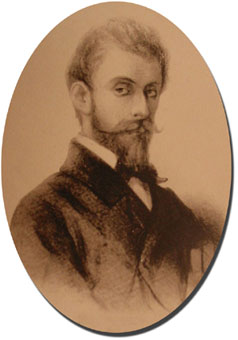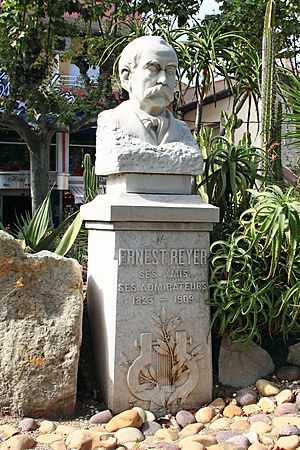Ernest Reyer facts for kids
Louis Étienne Ernest Reyer (born December 1, 1823 – died January 15, 1909) was a French composer who wrote operas. He was also a music critic, meaning he wrote reviews and opinions about music.
Contents
Ernest Reyer's Early Life
Ernest Reyer was born in Marseille, a city in France. His father was a notary, which is like a lawyer who deals with official documents. His father didn't want Ernest to become a musician. However, he didn't stop him from learning music. Ernest went to classes at the Conservatoire (a music school) from when he was six until he was sixteen.
In 1839, when he was 16, Ernest went to North Africa. He worked for his brother-in-law in Algeria, helping with money matters for the government. But this job wasn't a good fit for Ernest. He was quite relaxed and not very strict with rules. Records show that he wrote many stories, essays, and even dance pieces during this time. Some of his early music became famous locally. For example, a Mass (a type of church music) he wrote was performed at the cathedral in 1847.
Moving to Paris and Finding Inspiration
Reyer returned to Paris around 1848. There, he met many important artists like Gustave Flaubert and Théophile Gautier. Even though he was in Paris, he still loved the south of France and Provence. He would go back there to spend time with local people. He enjoyed playing dominoes and smoking his pipe. He even said his pipe was his best source of ideas!
His aunt, Louise Farrenc, helped him a lot with his early music studies. She was a piano professor at the Conservatoire and a talented composer herself.
Reyer's First Major Works
In 1850, Ernest Reyer created a large musical piece called Le Sélam. It was for singers and a choir, based on words by Gautier. Four years later, in 1854, he wrote music for a one-act opera called Maître Wolfram ("Master Wolfram"). The story for this opera was written by Joseph Méry.
When Berlioz, a famous composer, heard Maître Wolfram, he recognized Reyer's talent. Berlioz said that Reyer's music was "natural" and had "heart and imagination."
Growing Fame and New Ballets
Slowly, Reyer started to become more famous. In 1857, a critic named Charles Monselet wrote that he hoped Reyer would continue to make music and write. Not everyone praised him right away, though. Some critics felt that how he arranged music for different instruments (his orchestration) wasn't perfect yet.
The next year, in 1858, he composed a ballet called Sacountalâ. The story, again by Gautier, was based on an old Indian play called Shakuntala. This ballet was performed 24 times until 1860.
Success with La Statue
In 1861, Reyer composed an opéra-comique (a type of opera with spoken parts) in three acts called La statue ("The Statue"). Its story was inspired by the famous "One Thousand and One Nights" (also known as "Arabian Nights"). The words for the opera (the libretto) were written by Michel Carré and Jules Barbier.
La statue was first performed in Paris on April 11, 1861. It was a big hit! In less than two years, it was performed 60 times, which was a lot for that time.
Awards and Challenges
By 1862, Reyer's work was widely recognized. He received a special award from France called the Legion of Honour. In the same year, he composed another opera called Érostrate. This opera was performed in August 1862 in Baden-Baden, Germany, for important European families. This earned him another award, the Red Eagle, from the Queen of Prussia.
However, his fame started to fade a bit. The same opera, Érostrate, didn't do well in Paris. It was only performed three times, which meant it couldn't be shown at the main Paris Opera house.
Reyer's Most Famous Operas
The most well-known of Reyer's five operas is Sigurd (1884). It was very popular in France when it first came out. It was first performed in Brussels, Belgium, in January 1884. Sigurd is based on old Scandinavian legends, similar to the stories Richard Wagner used for his famous Ring cycle operas.
Even though Reyer admired Wagner, his music for Sigurd sounds quite different. Reyer followed the style of his mentor, Hector Berlioz. When you listen to Sigurd, you might hear parts that remind you of Berlioz's heroic music.
Reyer's last opera was Salammbô (1890). It was based on a novel by Gustave Flaubert. This opera was performed 46 times from May to December 1892. Like Sigurd, Salammbô had faced some challenges getting administrators to agree to stage it. It was first performed in Brussels in 1890, and then in Rouen, France.
Later Life and Legacy
Ernest Reyer couldn't make enough money just from his operas. So, he took over from Berlioz as a music critic for a newspaper called Journal des débats. He also worked as a librarian at the Académie de musique (a music academy).
Ernest Reyer passed away in Le Lavandou, a town in the south of France, about 80 kilometers (50 miles) east of Marseille.
Selected Compositions
- Chœur des buveurs et chœurs des assiégés, around 1848.
- Le sélam, 1850.
- Maître Wolfram, 1-act Opéra Comique, 1854.
- Sacountalâ, ballet, 1858.
- Chant des paysans (from Les Volontaires de 1814 by V. Séjour), 1861.
- La statue, 1861.
- Erostrate, 1862.
- L'hymne du Rhin, words by Méry, 1865.
- La Madeleine au désert, poems by Ed. Blau, 1874.
- Marche tzigane.
- Recueil de mélodies et de fragments d'opéras.
- Sigurd, 1884.
- Salammbô, 1890.
- Tristesse, poems by Ed. Blau, 1884.
- L'homme, poems by G. Boyer, 1892.
- Trois sonnets, poems by C. du Locle.
Selected Writings
- Notes de musiques, 1875.
- Notice sur Félicien David, 1877.
- Berlioz, 1894.
- Quarante ans de musique (1857–1899), published after his death in 1910.
See also
 In Spanish: Ernest Reyer para niños
In Spanish: Ernest Reyer para niños



